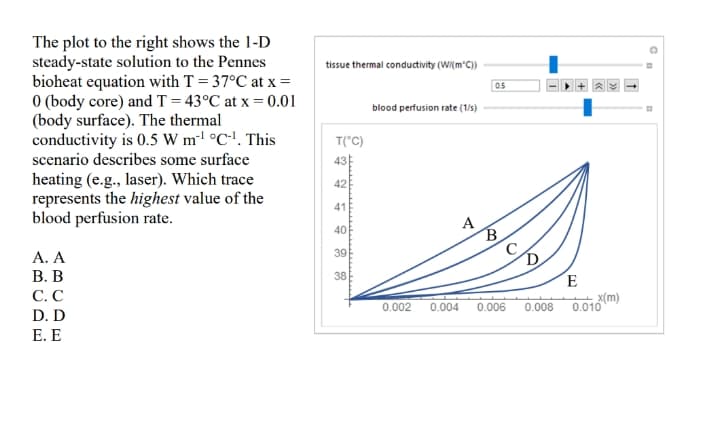The plot to the right shows the 1-D steady-state solution to the Pennes bioheat equation with T = 37°C at x = 0 (body core) and T = 43°C at x = 0.01 (body surface). The thermal conductivity is 0.5 W m °C'. This tissue thermal conductivity (Wi(m'C)) 0.5 blood perfusion rate (1/5) T("C) scenario describes some surface 43E heating (e.g., laser). Which trace represents the highest value of the blood perfusion rate. 42 41 A 40 А. А В. В 39 38 E С.С 0.002 x(m) 0.010 0.004 0.006 0.008 D. D Е. Е
The plot to the right shows the 1-D steady-state solution to the Pennes bioheat equation with T = 37°C at x = 0 (body core) and T = 43°C at x = 0.01 (body surface). The thermal conductivity is 0.5 W m °C'. This tissue thermal conductivity (Wi(m'C)) 0.5 blood perfusion rate (1/5) T("C) scenario describes some surface 43E heating (e.g., laser). Which trace represents the highest value of the blood perfusion rate. 42 41 A 40 А. А В. В 39 38 E С.С 0.002 x(m) 0.010 0.004 0.006 0.008 D. D Е. Е
Introduction to Chemical Engineering Thermodynamics
8th Edition
ISBN:9781259696527
Author:J.M. Smith Termodinamica en ingenieria quimica, Hendrick C Van Ness, Michael Abbott, Mark Swihart
Publisher:J.M. Smith Termodinamica en ingenieria quimica, Hendrick C Van Ness, Michael Abbott, Mark Swihart
Chapter1: Introduction
Section: Chapter Questions
Problem 1.1P
Related questions
Question

Transcribed Image Text:The plot to the right shows the 1-D
steady-state solution to the Pennes
bioheat equation with T = 37°C at x =
0 (body core) and T = 43°C at x = 0.01
(body surface). The thermal
conductivity is 0.5 W m-l °C-'. This
scenario describes some surface
tissue thermal conductivity (WI(m°C))
0.5
blood perfusion rate (1/5)
T("C)
43
heating (e.g., laser). Which trace
represents the highest value of the
blood perfusion rate.
42
41
A
40
А. А
В. В
39
38
E
С.С
0.002
X(m)
0.010
0.004
0.006
0.008
D. D
Е. Е
Expert Solution
This question has been solved!
Explore an expertly crafted, step-by-step solution for a thorough understanding of key concepts.
This is a popular solution!
Trending now
This is a popular solution!
Step by step
Solved in 2 steps with 2 images

Knowledge Booster
Learn more about
Need a deep-dive on the concept behind this application? Look no further. Learn more about this topic, chemical-engineering and related others by exploring similar questions and additional content below.Recommended textbooks for you

Introduction to Chemical Engineering Thermodynami…
Chemical Engineering
ISBN:
9781259696527
Author:
J.M. Smith Termodinamica en ingenieria quimica, Hendrick C Van Ness, Michael Abbott, Mark Swihart
Publisher:
McGraw-Hill Education

Elementary Principles of Chemical Processes, Bind…
Chemical Engineering
ISBN:
9781118431221
Author:
Richard M. Felder, Ronald W. Rousseau, Lisa G. Bullard
Publisher:
WILEY

Elements of Chemical Reaction Engineering (5th Ed…
Chemical Engineering
ISBN:
9780133887518
Author:
H. Scott Fogler
Publisher:
Prentice Hall

Introduction to Chemical Engineering Thermodynami…
Chemical Engineering
ISBN:
9781259696527
Author:
J.M. Smith Termodinamica en ingenieria quimica, Hendrick C Van Ness, Michael Abbott, Mark Swihart
Publisher:
McGraw-Hill Education

Elementary Principles of Chemical Processes, Bind…
Chemical Engineering
ISBN:
9781118431221
Author:
Richard M. Felder, Ronald W. Rousseau, Lisa G. Bullard
Publisher:
WILEY

Elements of Chemical Reaction Engineering (5th Ed…
Chemical Engineering
ISBN:
9780133887518
Author:
H. Scott Fogler
Publisher:
Prentice Hall


Industrial Plastics: Theory and Applications
Chemical Engineering
ISBN:
9781285061238
Author:
Lokensgard, Erik
Publisher:
Delmar Cengage Learning

Unit Operations of Chemical Engineering
Chemical Engineering
ISBN:
9780072848236
Author:
Warren McCabe, Julian C. Smith, Peter Harriott
Publisher:
McGraw-Hill Companies, The